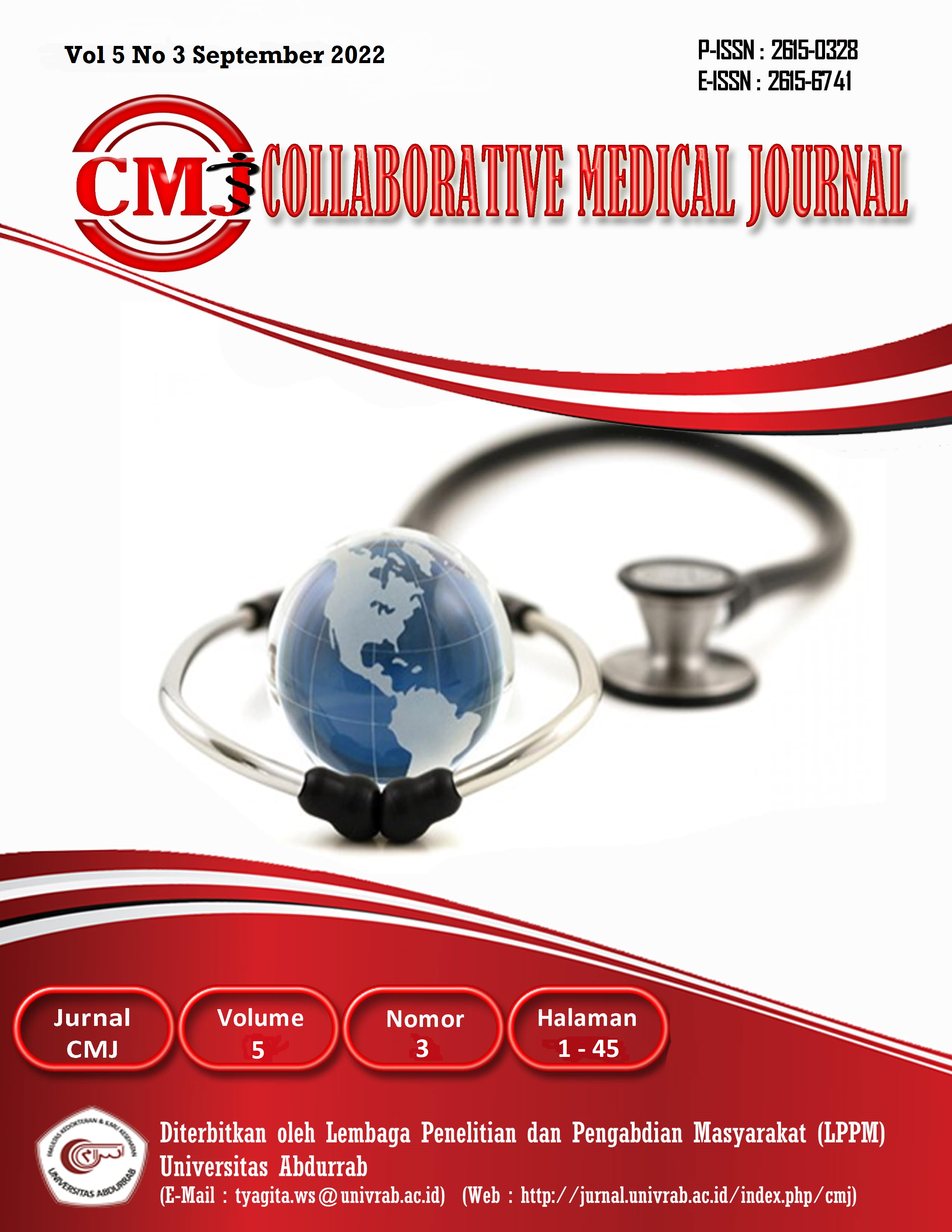MEKANISME RESISTENSI TERHADAP ANTI MIKROBA
Abstract
ABSTRACT
Resistance to antimicrobials is the resistance of microorganisms to antimicrobials that were previously effective against infections caused by these microorganisms. Bacterial resistance to antimicrobials can occur with any drug and is a major problem in the treatment of infections in hospitals and in the community. Infections caused by resistant microorganisms often fail standard treatments, resulting in prolonged treatment period, being more expensive, and even causing death. The mechanisms of bacterial resistance to antimicrobials vary and continue to develop, including antimicrobial inactivation, inhibition of entry of antimicrobials to the target site, changes in target molecules where antimicrobials bind, increased production of target molecules and changes in enzymes that activate antimicrobials. Genetic resistance can be intrinsic or acquired. Acquired resistance mechanisms occur through gene mutations then passed down vertically or through horizontal gene transfer. Mutations can occur spontaneously or adaptively, due to substances present in the environment (mutagens) such as chemicals, radiation and ultraviolet light. The main mechanism for the spread of antimicrobial resistance is by horizontal gene transfer. Genetic material that is transferred in a mobile form is in the form of plasmids, transposons and integrons and can be transferred by various mechanisms including conjugation, transformation and transduction.
Downloads
References
[1] Bockstael and Aerschot AV, “Antimicrobial Resistance in Bacteria,” Eur. J. Med., vol. 4, no. 2, pp. 141–55, 2009.
[2] Tilak, “Bacterial Resistance to Antibiotics: A Growing Public Health Problem,” McMaster Univ. Med. J., vol. 8, no. 11, pp. 58–62, 2011.
[3] WHO, “Antimicrobial Resistance,” WHO, 2021. [Online]. Available: www.who.int.
[4] H. A. Huttner A, Harbarth S, Carlet J, Cosgrove S, Goossens H, “Antimicrobial resistance: a global view from the 2013 World Healthcare-Associated Infections Forum,” Antimicrob. Resist. Infect. Control, vol. 2, no. 31, pp. 1–13, 2013.
[5] K. Ryan and Ray, Antimicrobial Resistance in Sherris Medical Microbiology: An Introduction to Infectious Diseases, Fourth Edi. USA: McGraw-Hill, 2004.
[6] Livermore, “Bacterial Resistance: Origins, Epidemiology and Impact,” Clin. Infect. Dis., vol. 36, no. 1, pp. S11-23, 2003.
[7] Vandepitte, Verhaegen, Engbaek, Rohner, Piot, and Heuck, Antimicrobial Susceptibility Testing in Basic Laboratory Procedures in Clinical Bacteriology, Second Edi. Jeneva: WHO, 2003.
[8] Tortora, Funke, and Case, Microbial Genetics and Antimicrobial Drugs in Microbiology, Tenth Edit. USA: Pearson Benjamin Cummings, 2010.
[9] Steinke and Davey, “Association between Antibiotic Resistance and Community Prescribing: A Critical Review of Bias and Confounding in Published Studies,” Clin. Infect. Dis., vol. 33, no. 3, pp. S193-205, 2001.
[10] Davies J & Webb V, Antibiotic Resistance in Bacteria in The Desk Encyclopedia of Microbiology. UK: Elsevier, 2009.
[11] Guilfoile, How Do Bacteria Resist Antibiotics in Deadly Diseases and Epidemics: Antibiotic Resistant Bacteria. USA: Chelsea House Publisher, 2007.
[12] K. B. Dzidic S, Suskovic J, “Antibiotic Resistance Mechanisms in Bacteria: Biochemical and Genetic Aspects,” Food Technol Biotechnol, vol. 46, no. 1, pp. 11–21, 2008.
[13] F. B. Harvey RA, Champe PC, Bacterial Genetics in Lippincott’s Ilustrated Reviews Microbiology, Fourth Edi. USA: Lippincott Williams & Wilkins, 2020.
[14] Z. R. Kayser FH, Bienz KA, Eckert J, Generial Bacteriology in Medical Microbiology. New York: Thieme, 2005.
[15] R. W. Bauman, E. Machunis-Masuoka, and J. E. Montgomery, Microbiology: With Diseases by Body System. 2012.
[16] M. T. brooks GF, Carrol KC, Butel JS, Morse SA, Microbial Genetics in Lange Medical Microbiology, Twenty Eig. USA: McGraw Hill, 2019.
[17] M. T. Brooks GF, Carrol KC, Butel JS, Morse SA, “Jawetz, Melnick, & Adelberg’s Medical Microbiology, 25th.” McGraw Hill, USA, pp. 432–437, 2010.
[18] Rowe, Magnus, and Mazel, “he Role of Integrons in Antibiotic Resistance Gene Capture,” Int. J. Med. Microbiol., vol. 29, no. 2, pp. 115–25, 2002.
[19] Mazel, “Integrons and The Origin of Antibiotic Resistance Gene Cassettes,” ASM News, vol. 70, no. 11, pp. 520–5, 2004.
[20] Poirel, Carrer, Pitout, and Nordmann, “Integron Mobilization Unit as a Source of Mobility of Antibiotic Resistance Genes,” Antimicrob. Agents Chemother., vol. 53, no. 6, pp. 2492–8, 2009.
[21] Pommerville, Microbial Genetics, Gene Transfer, Genetic Engineering and Genomics, Antimicrobial Drugs in Alcamo’s Fundamentals of Microbiology, Ninth Edit. Kanada: Jones and Bartlett., 2011.
[22] Leboffe and Pierce, Molecular Technique in A Photograpic Atlas for the Microbiology Laboratory, Fourth Edi. USA: Morton Publishing Company, 2011.
Copyright (c) 2023 Collaborative Medical Journal (CMJ)

This work is licensed under a Creative Commons Attribution-NonCommercial-ShareAlike 4.0 International License.
1. Copyright of all journal manuscripts is held by the Collaborative Medical Journal (CMJ)
2. Formal legal provisions to access digital articles of electronic journal are subject to the provision of the Creative Commons Attribution-ShareAlike license (CC BY-NC-SA), which means that Collaborative Medical Journal (CMJ) is rightful to keep, transfer media/format, manage in the form of databases, maintain, and publish articles.
3. Published manuscripts both printed and electronic are open access for educational, research, and library purposes. Additionally, the editorial board is not responsible for any violations of copyright law.
licensed under a Creative Commons Attribution-ShareAlike 4.0 International License.
 PDF
PDF
 Abstract views: 602
Abstract views: 602
 downloads: 2042
downloads: 2042

 :
:




